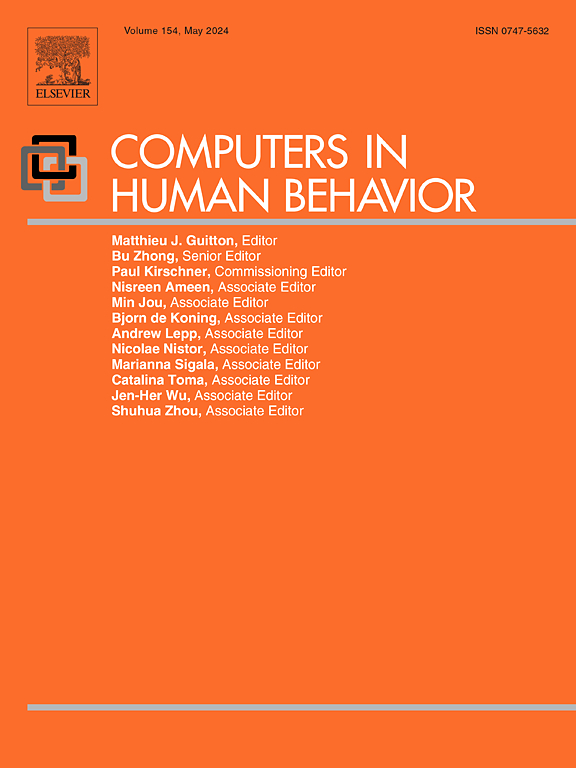青少年社交媒体使用的全球变化(2018-2022):对28个国家的生态分析
IF 8.9
1区 心理学
Q1 PSYCHOLOGY, EXPERIMENTAL
引用次数: 0
摘要
鉴于人们越来越关注社交媒体在青少年生活中的作用,特别是在2019冠状病毒病大流行之后,本研究调查了28个国家2018年至2022年社交媒体使用(SMU)的变化。研究的主要目的是检测2018年至2022年间四类社交媒体用户(即非活跃用户、活跃用户、密集用户和问题用户)的使用率所反映的青少年SMU的变化,并探索可能发生变化的几个个人、社会和国家因素之间的相互作用。数据来自28个国家的326,397名11岁、13岁和15岁的青少年,他们参与了学龄儿童健康行为研究。结果显示,非活跃用户的患病率略有下降(下降2.8个百分点),活跃用户(下降0.8个百分点)和密集社交媒体用户(下降1.6个百分点),同时问题社交媒体用户的患病率上升2.8个百分点。总的来说,这些时间变化在参与调查的国家得到了证实。女孩、青少年、低社会经济地位(SES)和中低家庭和同伴支持的人在报告的有问题的SMU中有更强的时间增长。年龄较小的青少年也表现出较强的非活动SMU的时间下降。现有的国家级指标(即GINI、GII、严密性指数、信息通信技术获取)对有问题的SMU的时间变化具有显著的调节作用。这些变化应该在当今日益技术化的世界的背景下加以解释。从全球预防的角度讨论了结果。本文章由计算机程序翻译,如有差异,请以英文原文为准。
Global change in adolescent social media use (2018–2022): An ecological analysis across 28 countries
Given growing concerns about the role of social media in adolescents' lives, especially after the COVID-19 pandemic, this study investigates changes in social media use (SMU) between 2018 and 2022 across 28 countries. The main aim is to detect any change in adolescents' SMU, as reflected in the rates of four categories of social media users (i.e., non-active users, active users, intense users, and problematic users) between 2018 and 2022, and explore interactions with several individual, social and national factors involved in possible changes. Data were gathered from 326,397 adolescents aged 11, 13, and 15 from 28 countries involved in the Health Behaviour in School-aged Children study. Results showed that there was a modest decline in the prevalence of non-active users (by 2.8 pp (percentage points)), active users (by 0.8 pp), and intense social media users (by 1.6 pp), accompanied by a 2.8 pp increase in the prevalence of problematic social media users. Overall, these temporal changes were confirmed across the participating countries. Girls, younger adolescents, those with low socio-economic status (SES), and with medium-low family and peer support experienced stronger temporal increases in reported problematic SMU. Younger adolescents also showed a stronger temporal decrease of non-active SMU. A significant moderation effect of available national-level indicators (i.e., GINI, GII, Stringency Index, ICT access) was identified with respect to temporal changes in problematic SMU. These changes should be interpreted within the context of today's increasingly technologized world. Results are discussed with a global preventive perspective.
求助全文
通过发布文献求助,成功后即可免费获取论文全文。
去求助
来源期刊

Computers in Human Behavior
Multiple-
CiteScore
19.10
自引率
4.00%
发文量
381
审稿时长
40 days
期刊介绍:
Computers in Human Behavior is a scholarly journal that explores the psychological aspects of computer use. It covers original theoretical works, research reports, literature reviews, and software and book reviews. The journal examines both the use of computers in psychology, psychiatry, and related fields, and the psychological impact of computer use on individuals, groups, and society. Articles discuss topics such as professional practice, training, research, human development, learning, cognition, personality, and social interactions. It focuses on human interactions with computers, considering the computer as a medium through which human behaviors are shaped and expressed. Professionals interested in the psychological aspects of computer use will find this journal valuable, even with limited knowledge of computers.
 求助内容:
求助内容: 应助结果提醒方式:
应助结果提醒方式:


